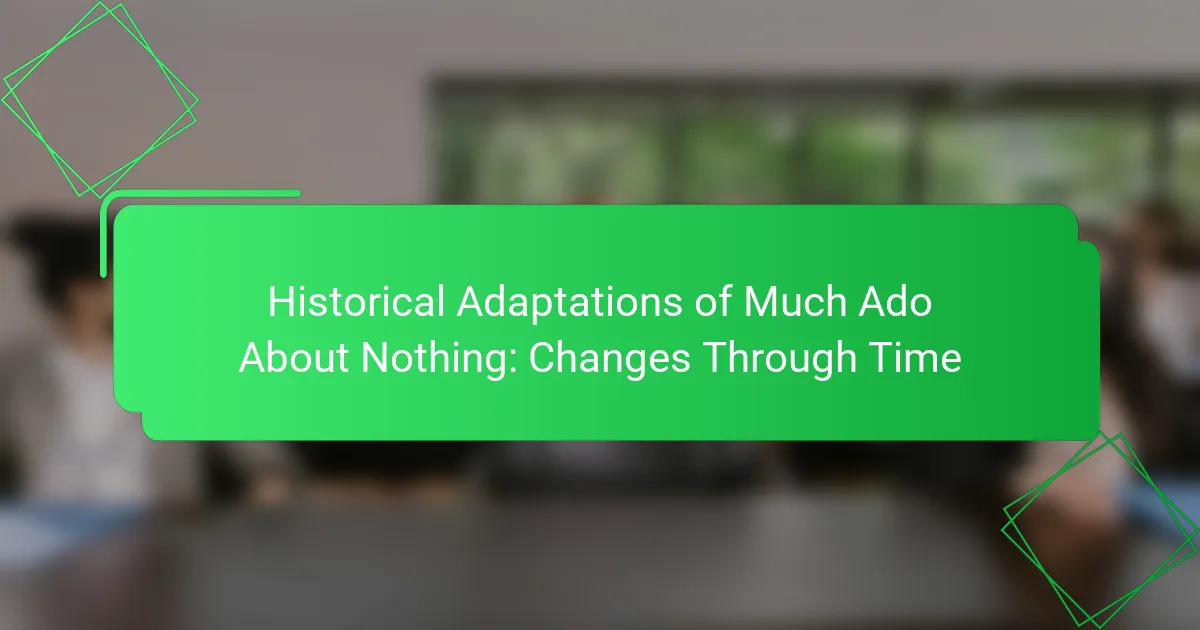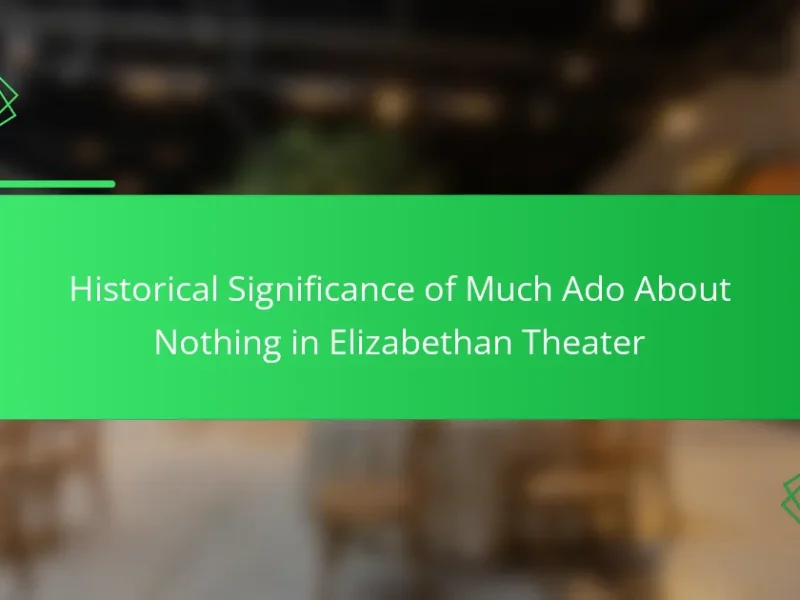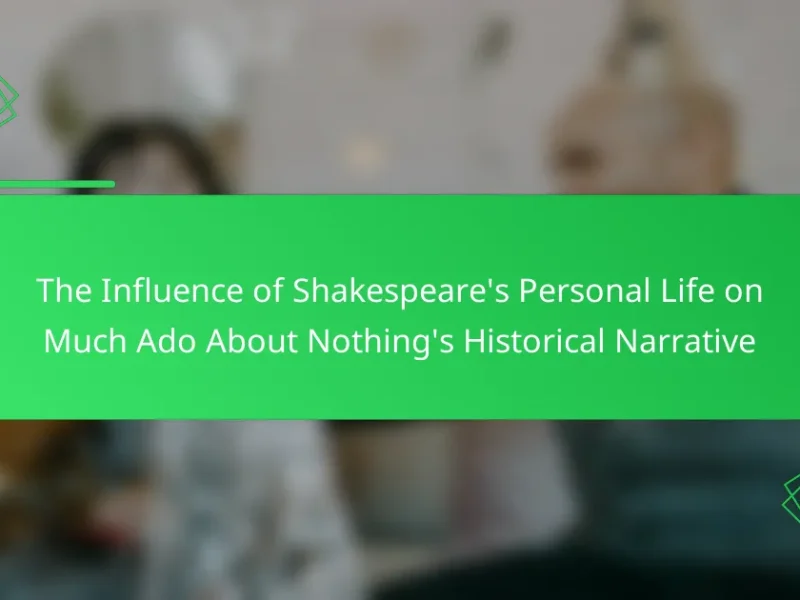
What are the Historical Adaptations of Much Ado About Nothing?
Historical adaptations of Much Ado About Nothing include various theatrical productions and film interpretations. Notable adaptations feature different cultural contexts and stylistic approaches. For instance, the 1993 film directed by Kenneth Branagh reimagined the play with a vibrant Mediterranean setting. The 2012 film adaptation by Joss Whedon presented a modernized version while retaining the original dialogue. Stage adaptations have also varied significantly, often reflecting contemporary social issues. Productions in different countries, such as a Japanese adaptation, highlight the play’s universal themes. These adaptations demonstrate the play’s enduring relevance and versatility across time and cultures.
How has Much Ado About Nothing evolved through different time periods?
Much Ado About Nothing has evolved significantly through different time periods. Originally performed in the late 16th century, it reflected the social norms and values of Elizabethan England. The play’s themes of love, honor, and deception resonated with contemporary audiences. In the 18th and 19th centuries, adaptations often emphasized romantic elements, aligning with the Romantic movement’s ideals. Modern adaptations frequently reinterpret characters and settings, making them relevant to contemporary issues. For instance, recent productions may focus on gender dynamics and consent. The play’s flexible structure allows for various interpretations across cultures and eras. Each adaptation highlights the timeless nature of its themes while reflecting the values of its time.
What are the key historical contexts that influenced its adaptations?
The key historical contexts that influenced adaptations of “Much Ado About Nothing” include the social norms of the Elizabethan era. During this time, gender roles were strictly defined, impacting character portrayals and relationships. The rise of the feminist movement in the 20th century shifted interpretations toward more empowered female characters. Additionally, post-war sentiments influenced adaptations to reflect themes of love and reconciliation. The advancements in technology and media also allowed for diverse interpretations, including film and stage adaptations. Each of these contexts shaped how the narrative and characters were presented over time.
How do cultural shifts reflect in the adaptations of Much Ado About Nothing?
Cultural shifts significantly influence the adaptations of Much Ado About Nothing. Each adaptation reflects contemporary social norms and values. For instance, feminist interpretations emphasize Beatrice’s independence and assertiveness. These adaptations often critique traditional gender roles present in Shakespeare’s original text. Modern settings may alter character dynamics to resonate with current audiences. In the 1993 film adaptation, the setting and costumes were updated while retaining the original dialogue. This approach makes the themes of love and deception more relatable to today’s viewers. Additionally, adaptations can incorporate diverse casting to reflect multicultural perspectives. Such changes demonstrate how the play evolves with societal attitudes over time.
What adaptations of Much Ado About Nothing have been most significant?
The most significant adaptations of Much Ado About Nothing include the 1993 film directed by Kenneth Branagh. This adaptation is notable for its star-studded cast and vibrant setting. It modernizes the comedic elements while retaining the original dialogue. Another important adaptation is the 2012 film directed by Joss Whedon. This version is set in a contemporary context with a minimalist style. It showcases a fresh interpretation of the characters and themes. Additionally, several stage adaptations have reimagined the play in various cultural contexts. These adaptations often highlight the play’s timeless themes of love and deception. They contribute to the ongoing relevance of Shakespeare’s work in modern times.
Which adaptations have received critical acclaim and why?
Several adaptations of “Much Ado About Nothing” have received critical acclaim. The 1993 film directed by Kenneth Branagh is particularly noted for its faithful yet vibrant portrayal of the text. Critics praised its ensemble cast and the film’s ability to blend humor with romance.
Another acclaimed adaptation is Joss Whedon’s 2012 version, which modernizes the setting while maintaining the original dialogue. It received positive reviews for its innovative approach and strong performances.
The Royal Shakespeare Company’s stage adaptations have also garnered acclaim for their fresh interpretations and strong directorial vision. These adaptations highlight the timelessness of Shakespeare’s themes, resonating with contemporary audiences.
Overall, the acclaim for these adaptations stems from their successful balance of fidelity to the original text and creative reinterpretation.
How do different adaptations reinterpret the original themes?
Different adaptations reinterpret the original themes of Much Ado About Nothing by altering character dynamics and societal contexts. For instance, modern adaptations may emphasize feminist perspectives, showcasing Beatrice as a more empowered figure. This contrasts with traditional interpretations that often depict her in a more subservient role. Additionally, some adaptations may shift the focus from romantic relationships to themes of friendship and loyalty. This reinterpretation can reflect contemporary societal values and challenges. Furthermore, the setting of adaptations can influence thematic interpretations. A contemporary urban setting may highlight themes of deception and misunderstanding in the context of modern relationships. These changes allow audiences to connect with the material in ways that resonate with current issues and sensibilities.

How do adaptations of Much Ado About Nothing reflect societal changes?
Adaptations of Much Ado About Nothing reflect societal changes by altering character dynamics and themes to match contemporary values. For instance, modern adaptations often emphasize gender equality and consent. This shift highlights the evolving views on women’s roles in society. In earlier versions, female characters were often portrayed in traditional, submissive roles. Current adaptations, however, showcase women as assertive and independent.
Additionally, the portrayal of romantic relationships has evolved. Modern adaptations may focus on the importance of communication and mutual respect. This contrasts with earlier interpretations that emphasized courtship and social status. The setting of adaptations also changes to resonate with current audiences. Contemporary versions may place the story in modern urban environments, making it more relatable.
These changes illustrate how adaptations serve as cultural reflections, adapting to societal norms and values over time. Each adaptation captures the essence of its time, demonstrating how Much Ado About Nothing remains relevant across generations.
What themes have been emphasized in various adaptations?
Various adaptations of “Much Ado About Nothing” emphasize themes of love, deception, and social status. Love is portrayed as both romantic and platonic, highlighting its complexities. Deception often serves as a catalyst for both conflict and resolution within the narrative. Social status is examined through character interactions, revealing class distinctions and societal expectations. These themes resonate across different time periods, reflecting contemporary values and concerns. For example, modern adaptations may stress gender roles and equality, while earlier versions focused on honor and reputation. Each adaptation uniquely interprets these themes to connect with its audience.
How do gender roles in adaptations differ from the original play?
Adaptations of “Much Ado About Nothing” often present gender roles differently than the original play. In the original, traditional gender roles are prominent, with men dominating public discourse and women largely confined to domestic spaces. Adaptations frequently modernize these roles, showcasing female characters with greater agency and independence. For instance, contemporary versions may depict Beatrice as a more empowered figure who challenges societal norms. This shift reflects changing cultural attitudes toward gender equality. Additionally, male characters may be portrayed with vulnerability, contrasting the stoic masculinity of the original. These adaptations highlight the evolving understanding of gender dynamics in society.
What social issues are highlighted in modern adaptations?
Modern adaptations of “Much Ado About Nothing” highlight issues such as gender roles, class disparity, and the impact of social media. Gender roles are often reexamined, showcasing the evolving dynamics between men and women. Class disparity is depicted through the contrast between different social standings, emphasizing economic inequalities. The influence of social media is portrayed, illustrating how public perception can affect personal relationships. These adaptations reflect contemporary societal concerns while maintaining the original narrative’s essence.
How have the artistic styles of adaptations changed over time?
Artistic styles of adaptations have evolved significantly over time. Early adaptations of “Much Ado About Nothing” often adhered closely to Shakespeare’s original text and Elizabethan staging conventions. As time progressed, adaptations began to incorporate modern elements and diverse cultural interpretations. The 20th century saw a rise in experimental and avant-garde interpretations, reflecting societal changes and artistic movements. Recent adaptations frequently utilize contemporary settings and technology, enhancing accessibility for modern audiences. For example, Joss Whedon’s 2012 film version presented the play in a modern-day context while retaining the original dialogue. This shift demonstrates the adaptability of Shakespeare’s work to resonate with varying artistic sensibilities and audience expectations.
What are the notable directorial choices in different adaptations?
Notable directorial choices in adaptations of “Much Ado About Nothing” include varying settings, character interpretations, and pacing. Directors often choose to set the play in different historical periods or contemporary contexts. For instance, Joss Whedon’s 2012 film adaptation is set in modern-day California. This choice impacts the audience’s connection to the characters and themes.
Character interpretations can differ significantly across adaptations. Some directors emphasize the comedic elements of Benedick and Beatrice’s relationship, while others focus on the darker themes of deception and betrayal. For example, Kenneth Branagh’s 1993 version highlights the romantic comedy aspect, showcasing the playful banter between the lead characters.
Pacing is another critical directorial choice. Some adaptations maintain the original text’s rhythm, while others condense dialogue for a faster narrative flow. The 1993 film, for instance, balances the original language with a brisker pace to appeal to contemporary audiences. These choices collectively shape the interpretation and reception of the play across various adaptations.
How do set designs and costumes reflect the time of the adaptation?
Set designs and costumes reflect the time of the adaptation by visually representing the cultural and social context of the period. For instance, adaptations set in the Elizabethan era feature authentic attire and architecture that mirror the historical fashion and design of that time. This includes the use of period-appropriate fabrics, colors, and styles that were prevalent during the 16th century.
In contrast, modern adaptations may incorporate contemporary clothing and set designs that resonate with current societal norms and aesthetics. This shift in visual elements helps audiences connect with the themes and characters in a more relatable manner.
Furthermore, specific adaptations can highlight significant historical events or movements, using set and costume choices to emphasize these influences. For example, a version set in the 1960s may utilize bold patterns and vibrant colors to reflect the cultural revolution of that decade.
Overall, set designs and costumes serve as crucial tools in conveying the time period of the adaptation, enriching the audience’s understanding of the narrative and its relevance.

What are the challenges in adapting Much Ado About Nothing?
Adapting Much Ado About Nothing presents several challenges. The play’s intricate language can be difficult for modern audiences to understand. Translating Shakespeare’s Elizabethan English into contemporary vernacular often loses nuances. The cultural context of the play is also a challenge. Themes of honor and gender roles differ significantly today. Maintaining the original tone while making it relatable is complex. Additionally, balancing humor and drama requires careful direction. The play’s structure may not align with modern storytelling techniques. These factors complicate the adaptation process while striving for authenticity and engagement.
What are common pitfalls in adapting classic works like Much Ado About Nothing?
Common pitfalls in adapting classic works like Much Ado About Nothing include losing the original context. Adaptations may overlook the historical and cultural nuances of the text. This can lead to misinterpretations of character motivations and themes. Another pitfall is modernizing dialogue excessively. Overly contemporary language can strip the work of its poetic quality. Additionally, adaptations may focus too heavily on visual spectacle. This can detract from the narrative depth and character development. Failing to understand the source material’s structure is also problematic. Changes to plot or character arcs can alienate audiences familiar with the original. Lastly, neglecting diverse casting can limit the adaptation’s relevance. Inclusive casting can bring new perspectives to the classic story.
How can adaptations remain true to the original while innovating?
Adaptations can remain true to the original while innovating by preserving core themes and character motivations. Maintaining the essence of the original work is crucial. Innovations can be introduced through modern settings or contemporary dialogue. This approach allows for relevance to current audiences. For example, adaptations may use updated cultural references while keeping the original plot intact. Additionally, visual styles and technologies can enhance storytelling without altering fundamental narratives. Successful adaptations often find a balance between homage and creativity. This method respects the source material while appealing to new interpretations.
What audience expectations must be considered in adaptations?
Audience expectations in adaptations include fidelity to source material, character development, and cultural relevance. Audiences often expect adaptations to reflect the original themes and messages. They also look for characters that resonate with contemporary values. Additionally, the pacing and tone should align with audience preferences. Visual and auditory elements must enhance storytelling without overshadowing it. Audience familiarity with the original work influences their expectations for innovation versus tradition. Adaptations may also need to address diverse audience demographics and perspectives. Meeting these expectations can enhance viewer engagement and satisfaction.
What lessons can be learned from the adaptations of Much Ado About Nothing?
Adaptations of Much Ado About Nothing illustrate the timelessness of its themes. They show how love, misunderstanding, and deception resonate across different cultures and eras. Each adaptation highlights the relevance of communication in relationships. For example, modern interpretations often emphasize gender dynamics and social issues. These adaptations reflect changing societal norms and values. They also demonstrate the flexibility of Shakespeare’s language and characters. By recontextualizing the story, adaptations reveal new insights into human behavior. Overall, these lessons underscore the play’s enduring significance in literature and society.
How can future adaptations benefit from past experiences?
Future adaptations can benefit from past experiences by analyzing successful elements and avoiding previous mistakes. Historical adaptations of “Much Ado About Nothing” provide insights into audience preferences. For example, adaptations that embraced modern themes resonated well with contemporary viewers. Conversely, adaptations that strayed too far from the original text often received criticism. By studying audience reactions and critical reviews, future adaptations can refine their approaches. This practice leads to more engaging and relevant interpretations. Additionally, leveraging innovative techniques used in past adaptations can enhance storytelling. Overall, learning from historical adaptations fosters continuous improvement and relevance in future productions.
What best practices should be followed in adapting Much Ado About Nothing?
Focus on the essence of the characters. Retain the wit and humor that define Much Ado About Nothing. Update the setting to make it relatable to contemporary audiences. Maintain the original language’s rhythm while allowing for modern interpretations. Ensure clarity in dialogue to enhance audience understanding. Emphasize the themes of love and misunderstanding, which are timeless. Incorporate diverse casting to reflect modern society. Utilize innovative staging techniques to engage viewers. These practices enhance relevance and connection to the audience.
The main entity of the article is “Much Ado About Nothing,” a play by William Shakespeare, which has undergone numerous historical adaptations over time. The article examines the evolution of these adaptations, highlighting significant productions, cultural contexts, and the impact of societal changes on character portrayals and themes. Key adaptations discussed include Kenneth Branagh’s 1993 film and Joss Whedon’s 2012 version, showcasing how they reflect contemporary values while maintaining the original dialogue. The article also addresses challenges in adapting the play, such as language difficulties and the balance between innovation and fidelity to the source material. Overall, it emphasizes the play’s enduring relevance and the lessons learned from its adaptations.


